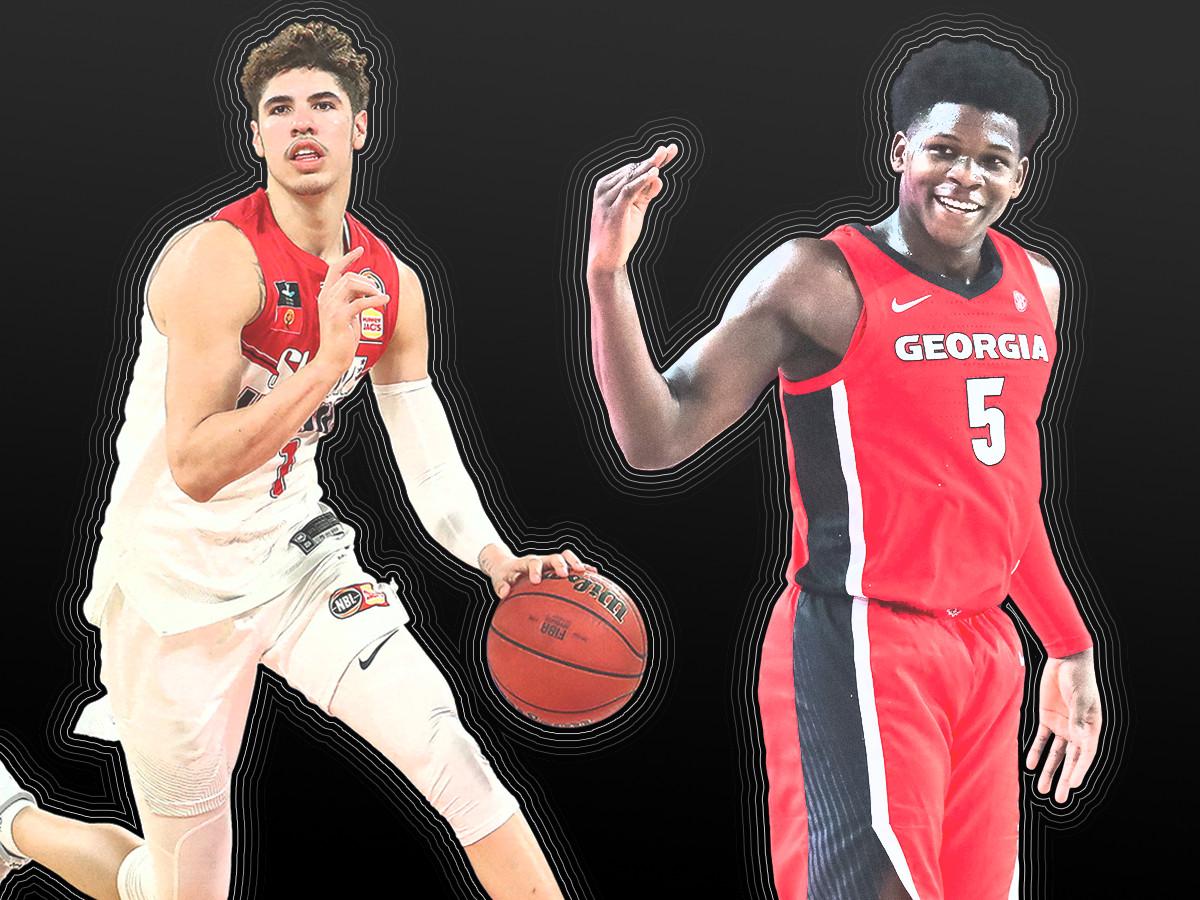Luka Doncic is why LaMelo Ball and Killian Hayes are considered the top two point guards in this year’s draft. Like Doncic, both Ball and Hayes made their names overseas and will need to use size and skill to make up for a lack of elite athleticism in the NBA. The question for the teams at the top of the 2020 NBA draft is which one can best follow the Mavericks star’s blueprint.
Doncic was more of a sure thing coming into the league. He was a near-finished product by 18, winning the MVP of the Spanish league and the EuroLeague Final Four in his final season before entering the draft. Hayes (who played in Germany and the EuroCup) and Ball (Australia) played in fewer games for worse teams against poorer competition. The Illawarra Hawks were 4-9 with Melo. Ratiopharm Ulm was 13-20 with Hayes. It’s not their fault that their teams weren’t more successful. They were teenagers playing against grown men. Just being good enough to be given that much responsibility is encouraging, but their relative struggles make what Doncic did two years ago even more impressive in hindsight.
Each guard was the engine of his team’s offense. Each had the ball in their hands for most of the game, leading the break in transition and running an endless number of pick-and-rolls in the half court. According to the tracking numbers at Synergy Sports, 41.9 percent of Hayes’s offense came as the ball handler on pick-and-rolls, ahead of Ball (32.9 percent) and Doncic (31.8 percent).
A high basketball IQ is the common thread for all three. The similarities between Luka and LaMelo are more obvious because both are skilled 6-foot-7 floor generals who use their size to see over the top of the defense and make daring passes that most can’t even attempt:
But don’t be fooled by the flashy passes and dribbling: LaMelo had an assist-to-turnover ratio of 2.7-to-1 in Australia. He’s a risk-taker who actually doesn’t take that many risks. He rarely gets flustered by defenses. There is always a plan when he makes a pass, even if it seems far-fetched.
Hayes, at 6-foot-5, isn’t quite as big. He has to work a little harder to create passing lanes. But he has the same ability to play with his head on a swivel and manipulate all five defenders with his dribble. He seems to know where everyone is on the court at all times. Even if he doesn’t dish out the assist himself, he makes the pass that leads to the pass:
The two prospects will face the same challenge as Doncic in the NBA, where they will be average athletes, at best. Both would get smoked by Anthony Edwards and James Wiseman, the other front-runners for the no. 1 pick, in any combine competition. There were plenty of times in Australia when Ball struggled to beat his man off the dribble or finish over defenders in the lane:
Hayes wasn’t as quick as many of the smaller point guards he faced in Germany. He was often cross-switched on defense to avoid tough matchups at his position. Jairus Lyles and Peyton Siva, who barely had cups of coffee in the NBA, made him look like he was standing in mud:
Doncic has overcome his subpar lateral quickness largely because it’s the only hole in his game. Hayes’s and Ball’s stats this season show that each of them is missing one crucial part of his formula in comparison to Luka’s final season overseas:
Luka vs. Killian and LaMelo
LaMelo wasn’t nearly as efficient offensively as Luka. It wasn’t just in one area of the floor, either. It was in all of them:
Luka vs. LaMelo
The problem starts with LaMelo’s unorthodox jumper. Like his older brother Lonzo at the same age, he doesn’t possess textbook form. He flares both of his elbows out and shoots from his chest. He’s also undisciplined with inconsistent motion as he goes up. And his feet are all over the place.
Those mechanics make it difficult for him to dribble into jumpers once he has a head of steam. He often winds up taking awkward push shots that are halfway between a pull-up jumper and a floater:
The threat of Luka’s jumper is the key to his success. He puts pressure on the defense as soon as he crosses half court. He’s never been an elite shooter (his career NBA 3-point percentage is 32.1 on 7.9 attempts per game), but he makes enough to force defenders to guard him. Luka has weaponized space. The farther up the court you have to defend someone, the harder it is to stay in front of them. He entered the league at the perfect time because modern coaches give their guards the green light to pull up from far behind the arc. Those shots are the equalizers that make slower guards like Luka play twice as fast as he would otherwise.
Defenses don’t have to worry about that with LaMelo. They can play a step off of him and go under any screens. And unlike Ben Simmons, he can’t just blow by defenders when they give him that much cushion.
The hope for any team drafting LaMelo is that an improved 3-point shot will have a cascading effect on his poor 2-point percentage. The concern I’ve heard from scouts is that those poor numbers might indicate an underlying lack of shooting touch that would make improvement more difficult. Free throw shooting percentages are the first numbers that most analytics people look at when evaluating a prospect’s shot. LaMelo (70.0 percent on 3.9 attempts per game) is in the range where they start to worry. Lonzo shot 67.3 percent on 2.7 attempts per game and wound up having to completely rebuild his shot in the NBA. Counting on LaMelo to do the same is a huge risk.
So which prospect should be rated higher? The argument for Hayes over Ball starts with his jumper. His raw 3-point-shooting numbers (29.4 percent on 3.1 attempts per game) aren’t much better, but you can see the difference in his free throw shooting (87.6 percent on 2.7 attempts) as well as his touch from 2-point range (58.8 percent on 5.5 attempts). Defenses know the difference. They press up on Hayes and force him to drive as much as possible. The degree of difficulty on his 3s is high. He takes a lot of stepbacks and pull-ups with a hand in his face:
But that is also a concern. Not many players can consistently make contested shots from 30-plus feet away. He would almost certainly have a higher 3-point percentage if he took easier shots, but a version of Hayes that doesn’t take those difficult shots wouldn’t have star potential. He struggled in a smaller role for Cholet Basket last season.
He needs to be empowered to be successful. But while an unlimited green light in Germany was good for Hayes’s career, it might not have been as good for his team. They went 6-1-1 and made it to the semifinals of the German league in their restart this summer, which he sat out to prepare for the draft. It’s hard to win with a limited athlete doing so much for your offense, unless he plays nearly perfect basketball. And Hayes is nowhere near perfect at this stage of his career. Like a lot of young left-handers, he rarely uses his right hand.
Hayes has less margin for error than Doncic and Ball. Doncic is a point guard who’s as big (6-foot-7 and 230 pounds) as Kawhi Leonard. For as much grief as he receives for not always being in shape, he uses his frame to overpower smaller players. He can shoot over defenders even when he can’t get past them. Hayes depends on his size, too. But many of these shots won’t be possible against bigger NBA defenders:
Basketball at the highest levels is a game of inches. Hayes just doesn’t have as many to spare. That’s why he’s a nonfactor on the glass, while rebounding is one of Luka’s most valuable skills. Oversized guards like Doncic and Ball (another excellent rebounder) can affect the game in ways that Hayes will never be able to.
Both Hayes and Ball have a long way to go to be the next Doncic. The former isn’t as big. The latter isn’t as good of a shooter. Doncic fell to the no. 3 pick in 2018 because NBA teams didn’t believe his formula from overseas would translate. We now know that it will. But there is more reason to worry about the next generation of point guards who share his weakness without having all his strengths.

